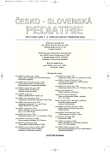-
Medical journals
- Career
Reflux Strictures of Esophagus in Children – Therapy and Results
Authors: M. Vyhnánek 1; O. Petrů 1; J. Šnajdauf 1; P. Kuklová 1; J. Lisý 2; V. Mixa 3
Authors‘ workplace: Klinika dětské chirurgie UK 2. LF a FN Motol, subkatedra dětské chirurgie IPVZ, Praha přednosta prof. MUDr. J. Šnajdauf, DrSc. 1; Klinika zobrazovacích metod UK 2. LF a FN Motol, Praha přednosta doc. MUDr. M. Roček, CSc. 2; Klinika anesteziologie a resuscitace UK 2. LF a FN Motol, Praha přednosta prof. MUDr. K. Cvachovec, CSc. 3
Published in: Čes-slov Pediat 2009; 64 (2): 57-62.
Category: Original Papers
Overview
Objective:
The selection of a suitable procedure for surgical solution of gastroesophageal reflux (GER) complications. Most severe complications of GER include reflux esophageal strictures. There are various therapeutic procedures: medication, dilation, dilation before or after surgery, antireflux plasty, or resection of stricture and anastomosis of esophagus or substitution of esophagus by stomach or intestine. The authors refer to advantages of preoperative medication in combination with dilation of esophageal stricture. In the algorithm there are immediate steps – surgery – antireflux plasty according to Nissen and again dilation of esophageal stricture. Long term results of this intervention proved to be very good.Method:
At authors workplace, 390 patients have been operated on for GER during 23 years. In 23 patients the operation was indicated for established reflux esophageal stricture (mean age at the time of operation was 7.5 years, range 10 months to 14 years). The study included 17 patients. After establishment of diagnosis, pharmacotherapy was initiated (antacids, cisaprid, H2 antagonists, omeprazol). The preoperative dilation of the stricture was performed in 7 patients (bougie dilation twice, balloon dilation five times). The preoperative dilation was indicated by a stricture causing difficulties in swallowing of liquids. The antireflux plasty according to Nissen followed. In two patients with very narrow stricture nutritional gastrostomy was applied at the same time. The dilation after thee surgery was performed in 10 patients (once to 9 times), dilation before and after the operation was made in 4 patients.Results:
The results were evaluated as very good in 15 patients since they did not suffer from clinical difficulties for more than a year and their conditions has not required further dilations. Two patients underwent repeated dilations of the cuff after fundoplication. Pharmacological treatment ended immediately after the operation. The patients have been further observed in out-patient department.Conclusion:
The therapy of reflux stricture would be complex – a combination of pharmacological, dilation and surgical treatment. As soon as the diagnosis is established, pharmacological therapy should ensue immediately. The dilation before the surgery should be made only in cases, when the patients experiences difficulties with swallowing of liquid food. Among available surgical procedures the authors prefer 360 degree fundoplication according to Nissen.Key words:
gastroesophageal reflux, reflux stricture, esophagitis, antireflux plasty according to Nissen
Sources
1. Rode H, Millar AJ, Brown RA, et al. Reflux strictures of the esophagus in children. J. Pediatr. Surg. 1992;27(4): 462–465.
2. Spitz L, McLeod E. Gastroesophageal reflux. Semin. Pediatr. Surg. 2003;12(4): 237–240.
3. Zeid MA, Kandel T, el-Shobary M, et al. Nissen fundoplication in infants and children: a long-term clinical study. Hepatogastroenterology 2004;51(57): 697–700.
4. Gossler A, Schalamon J, Huber-Zeyringer A, et al. Gastroesophageal reflux and behavior in neurologically impaired children. J. Pediat. Surg. 2007;42 : 1486–1490.
5. Numanoglu A, Millar AJ, Brown RA, et al. Gastroesophageal reflux strictures in children, management and outcome. Pediatr. Surg. Int. 2005;21(8): 631–634.
6. Briganti V, Oriolo L, Calisti A. Reflux strictures of the oesophagus in children: personal experience with preoperative dilatation followed by anterior funduplication. Pediatr. Surg. Int. 2003;19(7): 544–547.
7. Jawad AJ, Al-Samarrai AI, Al-Rabeeah A, et al. The management of esophageal strictures in children. Ann. Saudi Med. 1995;15(1): 43–47.
8. Othersen HB Jr, Ocampo RJ, Parker EF, et al. Barrett’s esophagus in children. Diagnosis and management. Ann. Surg. 1993;217(6): 676–680.
9. al-Bassam A. Surgical management of severe peptic esophageal stricture in children. Hepatogastroenterology 2003;50(51): 714–717.
10. Bosheva M, Chatalbashev N, Pechilkova M, et al. Peptic esophageal stricture in children. Folia Med. (Plovdiv). 1998;40(4): 24–28.
11. Šnajdauf J, Vyhnánek M, Vondráková L, et al. Dlouhodobé výsledky chirurgického řešení gastroezofageálního refluxu u dětí. Rozhl. Chir. 1997;76(8): 370–373.
12. Šnajdauf J, Škába R, et al. Dětská chirurgie. 1.vyd. Praha: Galén, 2005 : 1–164.
13. Ohhama Y, Tsunoda A, Nishi T, et al. Surgical treatment of reflux stricture of the esophagus. J. Pediatr. Surg. 1990;25(7): 758–761.
14. Lisý J, Hetková M, Šnajdauf J, et al. Long-term outcomes of balloon dilation of esophageal strictures in children. Acad. Radiol. 1998;5(12): 832–835.
15. Lisý J, Šnajdauf J, Šimsová M, et al. Kdy lze považovat balonkovou dilataci striktury jícnu u dětí za úspěšnou? Čes. Radiol. 2002;56(2): 82–86.
16. Nicka LM, Christie DL, Halt DG, et al. Surgical treatment of esophageal strictures secondary to gastroesophageal reflux. J. Pediatr. Surg. 1980;15 : 863–868.
17. Šnajdauf J, Pýcha K, Vyhnánek M, et al. Náhrada jícnu žaludkem v dětském věku. Rozhl. Chir. 1999;78(10): 515–519.
Labels
Neonatology Paediatrics General practitioner for children and adolescents
Article was published inCzech-Slovak Pediatrics

2009 Issue 2-
All articles in this issue
- Reflux Strictures of Esophagus in Children – Therapy and Results
- Mental Anorexia or Brain Tumor?
- Vaccination against Tuberculosis
- Genetically Determined Forms of Nephrotic Syndrome in Children
- Flow-mediated Dilation (FMD) – Ultrasound Evaluation of Function of Vascular Endothelium in the Population Groups at Risk
- Monogenic Hypertension
- Czech-Slovak Pediatrics
- Journal archive
- Current issue
- Online only
- About the journal
Most read in this issue- Vaccination against Tuberculosis
- Genetically Determined Forms of Nephrotic Syndrome in Children
- Reflux Strictures of Esophagus in Children – Therapy and Results
- Monogenic Hypertension
Login#ADS_BOTTOM_SCRIPTS#Forgotten passwordEnter the email address that you registered with. We will send you instructions on how to set a new password.
- Career

